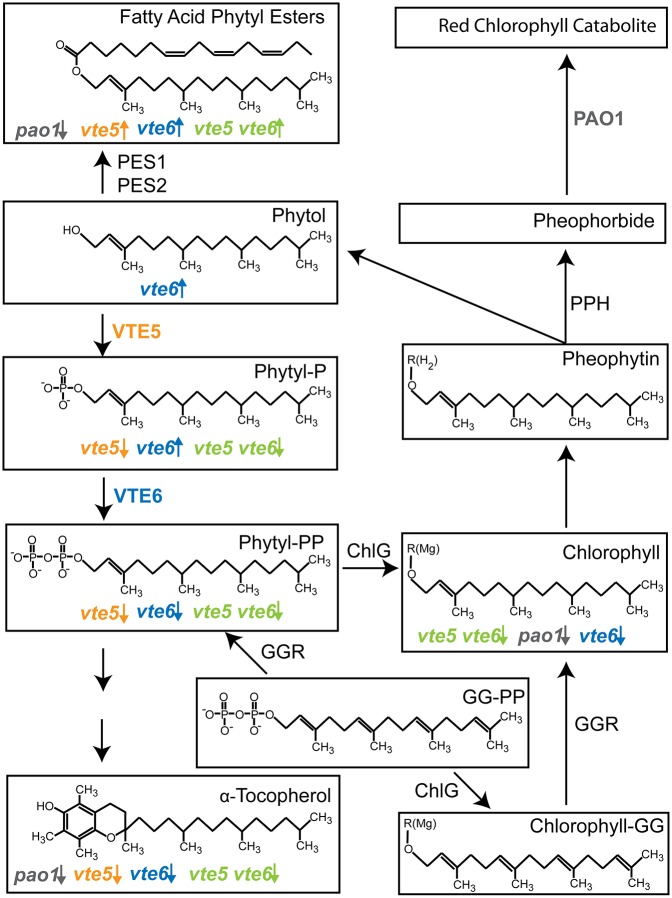Tocopherols, a subclass of tocochromanols that contain a phytol attached to the head group, act as antioxidants to protect lipids from oxidative damage, a particularly important function in chloroplasts and for seed longevity (reviewed in Maeda and DellaPenna, 2007). One pathway for tocopherol biosynthesis involves de novo synthesis from geranylgeranyl-diphosphate; the other pathway uses phytols derived from chlorophyll (see figure). In the latter pathway, the phytol kinase VITAMIN E DEFICIENT5 (VTE5) phosphorylates phytol; the phytyl-phosphate then undergoes a second phosphorylation to form phytyl-diphosphate, which feeds into tocopherol biosynthesis.
Metabolism of phytols. Degradation of chlorophyll produces phytol; phosphorylation of phytol by VTE5 and VTE6 produces phytyl-diphosphate, a precursor of tocopherol synthesis. Arrows show the changes in levels of each intermediate in the indicated mutants. R(Mg), chlorophyllide; R(H2), pheophorbide. (Based on vom Dorp et al. [2015], Figure 9.)
The phytyl-phosphate kinase was identified by a phylogenetic approach, comparing the genomic sequences of plants with those of algae and bacteria that contain chlorophyll and conduct oxygenic photosynthesis (Seaver et al, 2014). Here, vom Dorp et al. (2015) examine the Arabidopsis thaliana gene encoding this candidate kinase, terming it VTE6, based on subsequent characterization. Consistent with a role in tocopherol biosynthesis, VTE6 localizes to the chloroplast envelope. Moreover, vte6 mutants showed increased levels of phytyl-phosphate and severely reduced levels of tocopherol. Plants overexpressing VTE6 showed increased levels of phytyl-diphosphate and tocopherol. Finally, feeding experiments showed that wild-type plants could convert exogenous phytol to phytyl-diphosphate, but vte6 mutant plants could not, showing that VTE6 has phytyl-phosphate kinase activity. Also, Escherichia coli expressing VTE5 and VTE6 could produce phytyl-diphosphate from phytol.
The two pathways for tocopherol biosynthesis could act redundantly, or one pathway could predominate. Indeed, the leaves of pheophorbide a oxygenase mutants, which have a block in chlorophyll degradation, show low levels of total tocochromanols, supporting the importance of chlorophyll-derived phytol. These observations indicate that the chlorophyll-derived pathway predominates, as the vte6 mutant plants show severe deficiencies in tocopherol and suffer severe phenotypic consequences. In addition to having low levels of tocopherol, the vte6 mutants could not grow photoautotrophically; even on sucrose-supplemented media, the mutant plants were stunted and pale, with weak root systems. Homozygous vte6 mutants did not set seeds, but in the progeny of heterozygous mutants, the homozygous seeds showed reduced viability after storage. In addition to the effects of tocopherol deficiency, accumulation of the phytyl-phosphate intermediate might negatively affect the vte6 mutant plants, as, in contrast to vte6, other tocopherol-deficient mutants, such as vte1, 2, 4, and 5, can grow photoautotrophically. Supporting this idea, the vte5 vte6 double mutants showed less inhibition of growth compared with the vte6 single mutants.
As vitamin E, tocochromanols are an important part of the human diet and have commercial uses in preventing oxidation of vegetable oils; therefore, improving the tocopherol contents of plant oils and animal forage remains an ongoing aim (reviewed in Hunter and Cahoon, 2007). The discovery that phytol from chlorophyll degradation feeds the tocopherol biosynthesis pathway has interesting implications for metabolic engineering, as VTE6-overexpressing plants show increased tocopherol levels in leaves and seeds. If successful (and lacking detrimental side effects), such engineering will improve food and feed, help enable industrial applications of plant-derived oils, and potentially enhance seed longevity.
Supplementary Material
References
- Hunter S.C., Cahoon E.B. (2007). Enhancing vitamin E in oilseeds: unraveling tocopherol and tocotrienol biosynthesis. Lipids 42: 97–108. [DOI] [PubMed] [Google Scholar]
- Maeda H., DellaPenna D. (2007). Tocopherol functions in photosynthetic organisms. Curr. Opin. Plant Biol. 10: 260–265. [DOI] [PubMed] [Google Scholar]
- Seaver S., et al. (2014). High-throughput comparison, functional annotation, and metabolic modeling of plant genomes using the PlantSEED resource. Proc. Natl. Acad. Sci. USA 26: 9645–9650. [DOI] [PMC free article] [PubMed] [Google Scholar]
- vom Dorp K., Hölzl G., Plohmann C., Eisenhut M., Abraham M., Weber A.P.M., Hanson A.D., Dörmann P. (2015). Remobilization of phytol from chlorophyll degradation is essential for tocopherol synthesis and growth of Arabidopsis. Plant Cell 27: 2846–2859. [DOI] [PMC free article] [PubMed] [Google Scholar]
Associated Data
This section collects any data citations, data availability statements, or supplementary materials included in this article.



